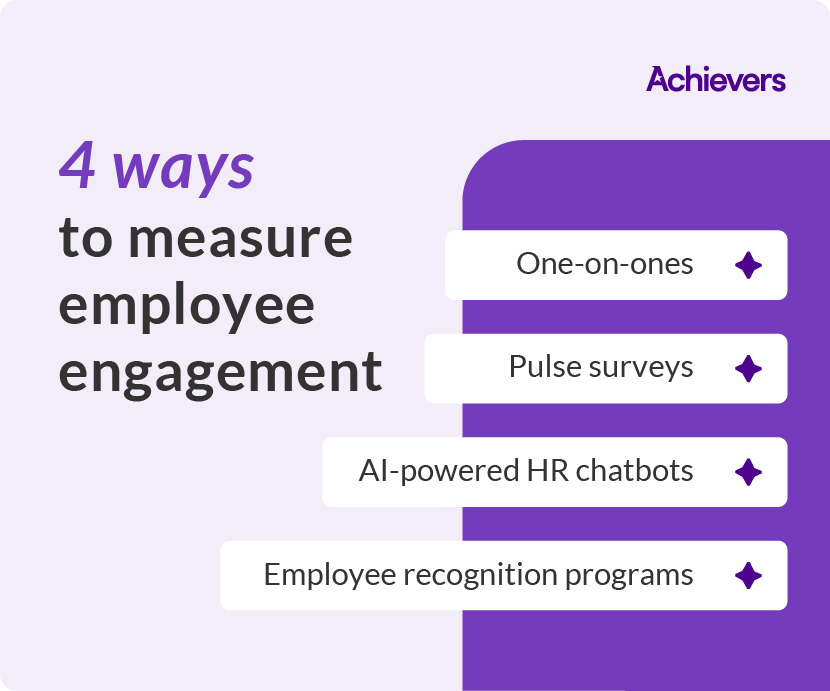Table of contents
Employee engagement shows how connected and committed employees feel at work. Engaged employees put extra effort into their tasks, support their teammates, and help build a positive workplace culture because they don’t want to work anywhere else. In fact, research from Achievers 2024 Engagement and Retention Report shows 72% of employees would prefer a job where they feel valued over a position that paid more but failed to offer any support or recognition.
Measuring engagement helps you understand what’s going well and where your people might need more support. It gives you the insight to make meaningful changes that strengthen connection, motivation, and performance.
Here’s a complete guide to measuring employee engagement, from how it can benefit your organization to the tools and best practices needed to track and improve it.
Why is measuring employee engagement worth it?
An engaged workforce drives productivity, sparks innovation, and strengthens customer relationships. Motivated employees take initiative, share ideas, and represent your company well — inside and outside the organization. They’re also more likely to stay, helping you retain valuable talent and reduce turnover costs.
Regularly measuring engagement helps you spot issues early and take action before they impact morale. It gives you clear data to uncover what’s holding people back and focus efforts where they’ll make the biggest difference. Acting on feedback shows employees you’re listening — and that their experience matters.

4 ways to measure employee engagement
Measuring employee engagement requires a multifaceted approach to ensure that team members always have an easy way to provide input whenever they have something to share. Offering a variety of feedback channels also lets employees choose the method they feel most comfortable with, increasing the chances of receiving honest thoughts from a broader cross-section of your workforce.
Here are four ways your company can solicit feedback from employees, no matter where they work:
1. Pulse surveys
Pulse surveys are focused questionnaires designed to gather quick insights into employee engagement. Unlike lengthy annual surveys — which often reveal issues long after the window to take effective action has closed — pulse surveys usually consist of a relatively small set of questions and are conducted on a frequent, consistent basis throughout the year. This steady stream of timely feedback lets organizations maintain an accurate picture of employee engagement and promptly address any weaknesses that emerge. The simplicity of pulse surveys also encourages higher participation rates, giving your HR professionals and leaders a more comprehensive data set.
2. One-on-ones
One-on-one meetings are valuable opportunities for managers to build strong relationships with employees through open communication and trust. These private sessions allow team members to share concerns, career goals, and workplace feedback. Leaders should ask about job satisfaction, challenges, and motivators. The answers, along with observations of the employee’s demeanor, offer insights into individual and team engagement levels.
3. AI-powered HR chatbots
Modern HR chatbots incorporate AI to interact with employees through a conversational interface, providing a stream of information on employee engagement in real time. By asking targeted questions and prompting employees to share their thoughts, chatbots can collect valuable data on engagement levels without the need for lengthy surveys. Chatbots also offer anonymity and convenience, encouraging more honest and frequent feedback from employees who might hesitate to share their opinions through other channels.
4. Employee recognition programs
Employee recognition is the primary driver of employee engagement, so creating and tracking participation in a recognition and rewards program is a great way to both improve and measure engagement. Ad hoc recognition is unlikely to make a significant impact on engagement levels, which is why your organization should implement a formal employee recognition program if it wants to see measurable results. Look for easy-to-use SaaS employee recognition platforms with features like built-in rewards catalogs, reporting and analytics capabilities, and thoughtful ways for employees to show appreciation.
5 key questions to ask when measuring employee engagement
If you’re looking to start measuring employee engagement at your organization, take a look at these five survey questions that address some of the major factors contributing to engagement.
1. How likely are you to recommend your company as a great place to work?
This question reveals your company’s Employee Net Promoter Score (eNPS), an HR version of the traditional customer-focused NPS. While not the be-all, end-all of measuring engagement, a high willingness to recommend your organization to others is a strong indicator that employees enjoy their jobs – and that your company has built a positive organizational culture.
2. How well do you understand your company’s goals and mission?
Few things motivate employees sustainably like a compelling mission statement and an inspiring company vision. Your organization should clearly define and communicate these guiding principles while ensuring that they’re reflected in the big and small actions your organization takes — from high-level corporate policies to the way you recognize employee anniversaries. When team members see that your company’s mission is more than just words, they’ll feel a real sense of purpose and belonging, and they’ll stay engaged with their tasks over the long haul.
3. How happy are you with your job?
Employee happiness is a straightforward reflection of how well your company is meeting the needs of its workforce. Highly satisfied team members are likely to stay with your organization longer and work harder, while an unhappy workforce signals underlying issues that your company should address.
4. Do you feel valued at work?
When employees believe that their contributions are noticed and genuinely appreciated by their manager and peers, they’re more likely to be committed to their work. If the responses to this question show that team members feel unacknowledged, consider adopting an employee recognition platform that makes it easy to show appreciation on a daily basis.
5. Do you have the resources and support needed to do your job effectively?
If employees aren’t empowered to succeed at work, their engagement is bound to suffer as they encounter frustrating roadblocks that turn simple tasks into recurring headaches. Beyond the basics, like necessary tools and other resources, ensure that workers are given the support from leadership they need to thrive. The difference between a boss who constantly micromanages and one who adopts a coaching approach is night and day when it comes to employee engagement.
Best practices for measuring employee engagement
In 2024, employee engagement in the U.S. fell to its lowest level in a decade, signaling a need for more thoughtful engagement solutions. So how can you set your team up for success? It starts with a thoughtful approach.
Keep these best practices in mind as you design your engagement strategy:
- Define your goals upfront: Know what you want to learn before you start collecting feedback. Focus your efforts on key areas like improving retention, strengthening your employer brand, or measuring the impact of recent changes. Clear goals help ensure the questions you ask are relevant and the data you gather is meaningful.
- Protect employee anonymity: Offer confidential feedback channels to help employees feel safe sharing honest thoughts. Without anonymity, employees may hold back — limiting the value of your insights.
- Communicate the “why” clearly: Let employees know why you’re collecting feedback and how it will be used. Explain the impact of their input and reinforce that their voices help shape the workplace.
- Act on feedback: Insights only matter if you use them. Share what you’ve learned, then create action plans with employees to address what matters most. Following through builds trust and strengthens engagement.
When you follow these best practices, you turn engagement measurement into more than a data collection exercise — you build a culture of listening, action, and continuous improvement.
The role of employee engagement software
Measuring and analyzing engagement data in real time isn’t possible without a dedicated employee engagement platform. Employee engagement software acts as a centralized system for gathering information from various feedback channels, ensuring that it’s always readily available for analysis.
Look for a platform that includes modern feedback tools, like pulse surveys and AI-powered chatbots, along with reporting tools that let HR professionals and managers visualize and interpret engagement data. Ensure your chosen software integrates the existing systems HR personnel and other employees already use every day as well, so it’s always easy for them to dive into the data or provide feedback.
And don’t forget to select a platform that guides your leaders as they create and manage action plans together with their teams, as the only way to drive meaningful improvements at your company is by turning insights into actionable strategies.
Measure employee engagement the right way
Measuring engagement is just the first step. What truly drives impact is taking action — recognizing the behaviors that move your company forward, and creating a culture where every employee feels seen, heard, and valued.
Achievers’ recognition platform helps you do exactly that. With real-time feedback tools and recognition built right into the flow of work, Achievers makes it easy to gather insights and act on them. You’ll uncover what motivates your people, strengthen connections, and shape the behaviors that drive business success. Backed by expert support, AI-powered insights, and a global rewards marketplace, Achievers helps organizations build lasting engagement and improve retention — all while delivering measurable results.
Ready to make engagement part of how your company works every day? See how Achievers can help you turn recognition into real impact.



